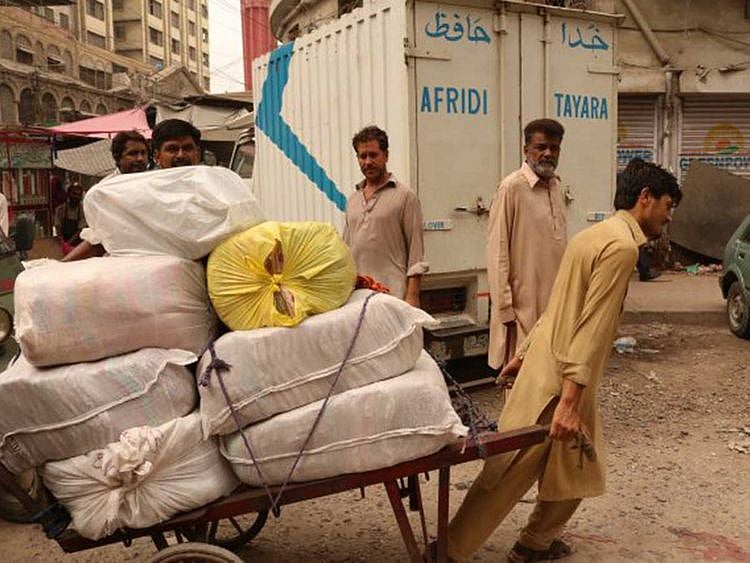COVID-19: Millions of migrant workers in Pakistan face threat of layoffs due to lockdown
Country grapples to combat economic crisis as coronavirus cases jumped to more than 4000

Dubai: Pakistan grapples to combat economic crisis as the confirmed coronavirus cases jumped to more than 4000 on Wednesday morning with 58 deaths.
The migrant workers who mostly include those who work on daily wages are facing the worst situation due to countrywide lockdown with business shut. Out of around 8.51 million migrant workers in Pakistan, some 3.78 million are facing direct threat of layoffs and this process has already kicked off in major urban centers of the country, according to report released by the Pakistan Institute of Development Economics (PIDE) — an Islamabad-base research institute.
58 deaths and 4072 cases
The total tally of confirmed coronavirus cases in Pakistan has jumped to 4072 on Wednesday with 58 deaths while 467 patients have recovered. Pakistan’s most populated Punjab province has been the worst-hit with 2030 cases following by Sindh 932, Gilgit-Baltistan 211, Balochistan 202, Islamabad 83 and Pakistan Administered Kashmir with 19 cases. The country has been under lockdown while flight operation has also been shut down until April 14.
The report titled ‘Protecting the Internal Migrant Workers’ authored by Nasir Iqbal, a leading researcher at PIDE highlighted the plight of Pakistani migrant workers who travel within Pakistan especially to big cities to earn living.
Businesses shut down
“With the calls for social distancing and lockdown, the COVID-19 outbreak has shutdown business operations across the country. As projected, millions of people are facing potential layoffs but the situation is doubly bad for the internal migrant workers who are staying away from homes to earn a livelihood,” said the report.
“While we worry about remittances from the overseas workers, these internal migrant workers remain largely ignored in all our discussions,” it added.
8.5 million workers
The official statistics show that around 8.51 million migrant workers are working across Pakistan (based on the Labor Force Survey 2017-18). And 45 per cen of them are engaged in informal activities including day labourers, construction workers, domestic helpers or factory workers.
More than 65% migrant workers are residing in only 15 districts across Pakistan, with over a million workers just in Karachi, followed by major numbers in Lahore, Faisalabad, Rawalpindi and Islamabad.
The closure of business activities would force the owners to layoff their employees. Some have already started doing that. We assume that informal workers, which comprise 45% of the total migrant labour force, would be the first ones to be laid-off. This means around 3.78 million migrant workers would be left without their source of livelihood, the report added.
No place to live
Majority of internal migrant workers are working in wholesale and retail, manufacturing, construction, transport and communication sectors, so employees in these sectors are expected to be hit the hardest. Many of these daily wagers reside in the factory dormitories, which being shut now leave them with no place to live. With the bus and train services halted, they are left stranded with no place to go
The PIDE report also states: “We must also remain aware that some of these internal migrants might also return home as they do after festivals. Reportedly, such return to the hometown did become an issue. With a prolonged lockdown there could be a possibility of a return migration”.
PIDE suggestions to save Intra-country migrant workers
1-The social protection packages announced by the federal and provincial governments should include migrant workers while targeting the vulnerable workers regardless of domicile.
2- There should be a provision to accommodate the migrant workers in their current district of employment to reduce massive movement from the place of employment to their hometowns, as has been witnessed in India. The current practice of local administration requiring people to register in hometown for getting the unconditional cash transfers of Rs12000 for registration under the Ehsaas programme should be reviewed. It will lead to unnecessary movement and run counter to the lockdown intentions for corona prevention.
3-Migrant workers, mainly the daily wage workers, need shelter during this period. Panahgahs should be opened for them as well, providing them the much-needed shelter and food. Soap and other hand washing facilities should also be provided to reduce the risk of COVID-19 spread.
4- In cases where the internal migrant has his/her family with them, and they want to remain in whatever humble abode they have, they should be made part of any public relief initiative. A huge proportion of children, among the seasonal migrants that travel with families, are malnourished and any loss of wages further accentuates that. To save that from happening, rations need to reach them
Sign up for the Daily Briefing
Get the latest news and updates straight to your inbox
Network Links
GN StoreDownload our app
© Al Nisr Publishing LLC 2025. All rights reserved.